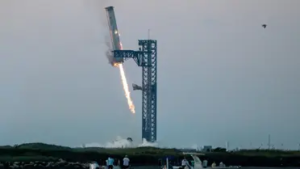SpaceX successfully catches giant starship booster during fifth test flight

On October 13, 2024, SpaceX completed its sixth flight test of the Starship system, marking a significant milestone. For the first time, SpaceX’s “Mechazilla” tower, a collection of massive mechanical arms designed for rocket recovery, successfully captured the Super Heavy booster. This maneuver represents a significant step forward in SpaceX’s quest for entirely reusable rockets, which would substantially cut costs and turnaround time between flights.
After launching from Boca Chica, Texas, the booster separated from the Starship and conducted a controlled fall using grid fins and three Raptor engines. It was grabbed in mid-air by the launch tower’s mechanical arms, a first for this scale. The second stage of the Starship continued to fly, reentering Earth’s atmosphere and splashing down safely in the Indian Ocean.
This test moves SpaceX closer to its goal of developing a fully reusable spacecraft for missions to the Moon, Mars, and beyond, which dramatically advances the possibilities for human space travel.
This landing technology is an important step toward SpaceX’s goal of making space travel more affordable and frequent by allowing rockets to be reused quickly. The ability to grab the rocket mid-air might substantially cut the time between launches, which is important for the company’s plans for interplanetary travel.
While Super Heavy was apprehended, the second stage of the system, Starship, continued its mission. It reached space and reentered Earth’s atmosphere at speeds of up to 17,000 miles per hour before splashing down safely in the Indian Ocean near Australia. This was another successful step toward SpaceX’s aim of completely reusable spaceflight.
The ultimate purpose of Starship is to support missions beyond Earth. SpaceX envisions the Starship transporting cargo and passengers not only to low Earth orbit, but also to the moon and mars. NASA has already selected Starship as part of its Artemis mission, which aims to place astronauts on the Moon by 2026.


